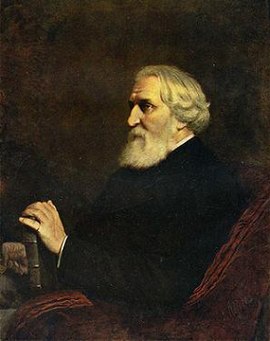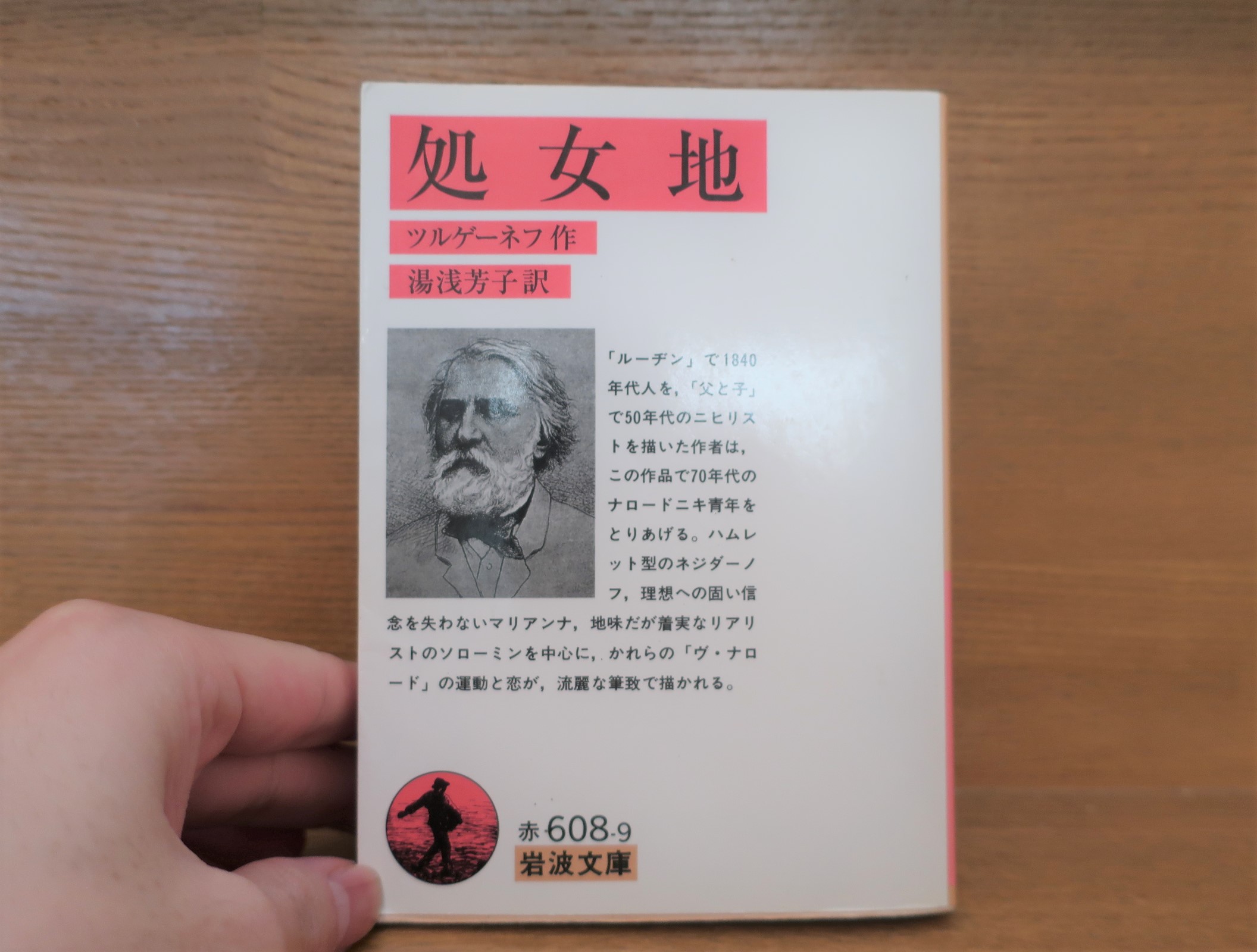Synopsis of Turgenev's "The Virgin Lands" Commentary - perfect for comparison with Dostoevsky's "Evil Spirits"!

Turgenev (1818-1883)Wikipedia.
The Virgin Land is a full-length novel published by Turgenev in 1877.
I read "The Virgin Land" translated by Yoshiko Yuasa, Iwanami Shoten.
Let's take a quick look at the cover synopsis.
The author, who portrayed the 1840s in "Luzhin" and the nihilists of the 1950s in "Father and Son," takes up the Narodniki youth of the 1970s in this work. In this work, the author depicts in flowing strokes the movements and loves of the Narodniki youth of the 1970s, centering on the Hamlet-type Nejdanov, Marianna, who never lost her firm belief in ideals, and Soromine, a sober but steady realist.
Iwanami Shoten, The Virgin Land, translated by Yoshiko Yuasa
The novel was Turgenev's last major work, written in the last years of his life, and as the synopsis states, he wrote the novel about the youth of the 1970s.
A more detailed explanation is given at the end of the book. It describes Turgenev's steps up to the time when this work came out.
Ivan Sergeyevich Turgenev (1818-1883) published his first long (or more precisely, medium-length) work, Luzhin, in 1856,
The Aristocrat's Nest, 1859)
The Night Before" (1860)
Father and Son" (1862)
Smoke" (1867)
The Virgin Land" (1877)In this order, he published his six famous long stories.
All of these long works attempt to depict the reality of Russian society in the four decades before and after the emancipation of the serfs (1861) and from the forties to the seventies of the nineteenth century, capturing the social and historical characteristics of Russian society in each period and focusing on these themes.
In other words, Turgenev, who portrayed people of the 40s in "Luzhin" and people of the 60s in "Father and Son," portrays people of the 70s in "The Virgin Land.populist groupIt is a portrait of a young man.
Iwanami Shoten, translated by Yoshiko Yuasa, The Virgin Land, p. 475
Turgenev tried to depict in this work.populist groupThe following is an explanation of who the youth are.
The revolutionaries of the 1960s and 1970s, i.e., the People's Faction, were mainly city-bred Razno-Chinese intellectuals who were not familiar with the conditions in the countryside. He overestimated the so-called "opsichina" and "mir" in rural Russia and regarded them as "happy organizations of people's labor with a socialist spirit," and recognized in them the peculiarity of Russia, which had different economic and land conditions from those of Europe, and he also recognized that such Russia was a land of capitalist development and proletarianization of the workers. He contrasted Russia with Europe, which was experiencing the development of capitalism and the proletarianization of workers, and said, "The misery of Europe, a situation with no way out, is our lesson,land partnershipThe "village clans" of the peasants and the "artisans" of the artisans were the singular basis of social life that would save Russia from capitalism and proletarianization, and they looked to the peasant class as the pillar on which they could rely for their revolutionaryism and to which all their hopes were linked. They pinned all their hopes on the peasant class.
In the spring of 1874, in order to reach out directly to the people, the youth of the People's Faction entered the countryside in disguise with false passports and distributed illegal pamphlets in an attempt to arouse the peasants to riot, but in reality they had to go through a painful drama.
In other words, the real peasants were never what they portrayed.
Iwanami Shoten, translated by Yoshiko Yuasa, The Virgin Land, p478-479
As for what a Narodniki youth is, it is a bit complicated, as explained above, but on the contrary, I think it somehow conveys the fact that there was a tendency for such a complicated theory to be praised.
And the young men and women who, based on such socialist theories, infiltrated rural villages under false identities, incited riots, and attempted to overthrow the social system were the Narodniki youth of the 1970s that Turgenev was trying to depict.
However, as will be discussed at the end of this commentary, they end up being nothing more than a mob that does not know the reality of rural communities and merely wants to collapse society according to their theories.
And interestingly, Dostoevsky'sEvil Spirits."But the same themes are depicted.
Let's also take a look at the synopsis of "Evil Spirits."
AmazonProducts Page.
Russia is in a period of transition, a time of turmoil and confusion, when all old values have collapsed due to the Emancipation of the Peasants Decree of 1861. Young men and women, driven by anarchism and atheism, organize themselves into secret societies and plot the overthrow of Russian society. --In the Bible, a herd of pigs possessed by an evil spirit jumps into a lake and drowns.
It was precisely around 1870 that "Evil Spirits" was written.
This overlaps exactly with the youth of the 1970s that Turgenev was trying to portray.
Turgenev described a stream of militants who believed in socialist ideology infiltrating rural villages and starting riots.
In contrast, Dostoevsky depicted the havoc and gruesome events of socialist revolutionaries in a certain city.
Although the stage is different, the two share a common awareness of the issues.
Although "Evil Spirits" is by far the more prominent in terms of the story's seriousness and dreadful blackness, the perspective of "The Virgin Land" is also very interesting.
While Dostoevsky brings to the forefront the gory blackness of human nature, Turgenev is in his element in analyzing and vividly depicting social conditions.
I feel that we can learn more deeply about the human spirit of this era by looking at the works of two people with different literary styles.
It seemed to me to be a very informative piece on "Evil Spirits."
impressions
We have seen "The Virgin Land" in connection with Dostoevsky's "Evil Spirits," but this work also shows Turgenev's artistic sense without regret.
of the previous workSmokeThe last scene of the "The Last Scene" was also astonishing in its artful depiction, and there was another wonderful depiction in this work that made me groan.
I would very much like to share the scene with you here.
The scene is mid-May, early summer in Russia, when the main character, Nejdanov, goes for a walk in the forest.
It was halfway through May, and for the first time the hot summer days continued. -After the history lesson, Nejdanov went out into the garden and walked further into the birch forest that bordered it. -The forest had been taken by merchants some fifteen years ago, or perhaps it had been cut down, and young birch trees were growing all over the place.
Dense tree trunks are softlusterIt stood like a post of erased silver with grayish horizontal rings. The small leaves were bright, friendly, and lush, as if someone had washed and lacquered them. Young spring leaves sprouted like pointed tongues from the flat layer of dark straw-colored fallen leaves.
narrowsmall diameterThe black, yellowish black beak of thethrush (esp. the dusky thrush, Turdus naumanni)The bird was flying low and close to the ground, and then it flew headlong into the bushes.
After walking for half an hour, Nejdanov finally sat down on a tree stump. All around him were old gray wood chips that had been felled by an axe,piled up highIt had become a
Winter snows covered it again and again, and in the spring they melted - no one touched it. Nejdanov sat with his back to the young birches that grew all around him like a wall, in the thick but brief shadows. He was sitting there without thinking, completely absorbed in the sensation of spring.
It is a special springtime feeling that is always tinged with melancholy in young and old hearts alike - a melancholy of surging anticipation in the young, and a melancholy of still, unmoving regret in the old. ......
Iwanami Shoten, translated by Yoshiko Yuasa, The Virgin Land, p. 89
*It pains me to break up the novel, but I did break up some of the lines.
I'm in the middle of this.Young spring leaves sprouted like pointed tongues from a flat layer of last year's dark straw-colored fallen leaves."I was struck by the expression "I'm not a fan of this.
Living in Hokkaido, I find this expression particularly poignant.
It is that warm springtime when last year's fallen leaves emerge from the melting snow and young leaves sprout from them, heralding the arrival of spring. For those of us from northern Japan who have endured the cold winter, the spring weather and the sprouting of new greenery are a moving moment every year.
And best of all, I like the phrase, "Young spring leaves were sprouting like pointed tongues. This expression reveals the movement of young leaves as if they are just sprouting. It is as if you can feel the warm life force of spring. This really made me numb!
Turgenev's beautiful depiction of nature is overwhelming. It is as if such a scene appears before your eyes.
And not only does he bring the scene to life before your eyes, but Turgenev captures the most beautiful moments perfectly. My hat is off to him.
I have read Turgenev's works at length so far, but the passage that has stayed with me the most is this one. This is the passage that has stayed with me the most. If you ask me what art is in literature, I am sure that I will think of this passage in the future.
The last scene of the previous film "Smoke" was wonderful, but this one was even more beautiful.
For me, these two scenes from "The Virgin Land" and "Smoke" are the two-top of Turgenev's art.
I am sure there are many literary experts who would disagree with me, but in terms of art, I think these two works had the greatest personal impact on me.
Diary of a Hunter.andAsha.", ,The Aristocrat's NestI personally recommend "Smoke" and "The Virgin Land," both of which showcase Turgenev's matured brushwork.
The above is a synopsis of Turgenev's "The Virgin Lands" - a great film about the Narodniki youth of the 1970s in Russia.
Next Article.
Click here to read the previous article.
Click here for a list of Turgenev's recommended works.
Related Articles





































